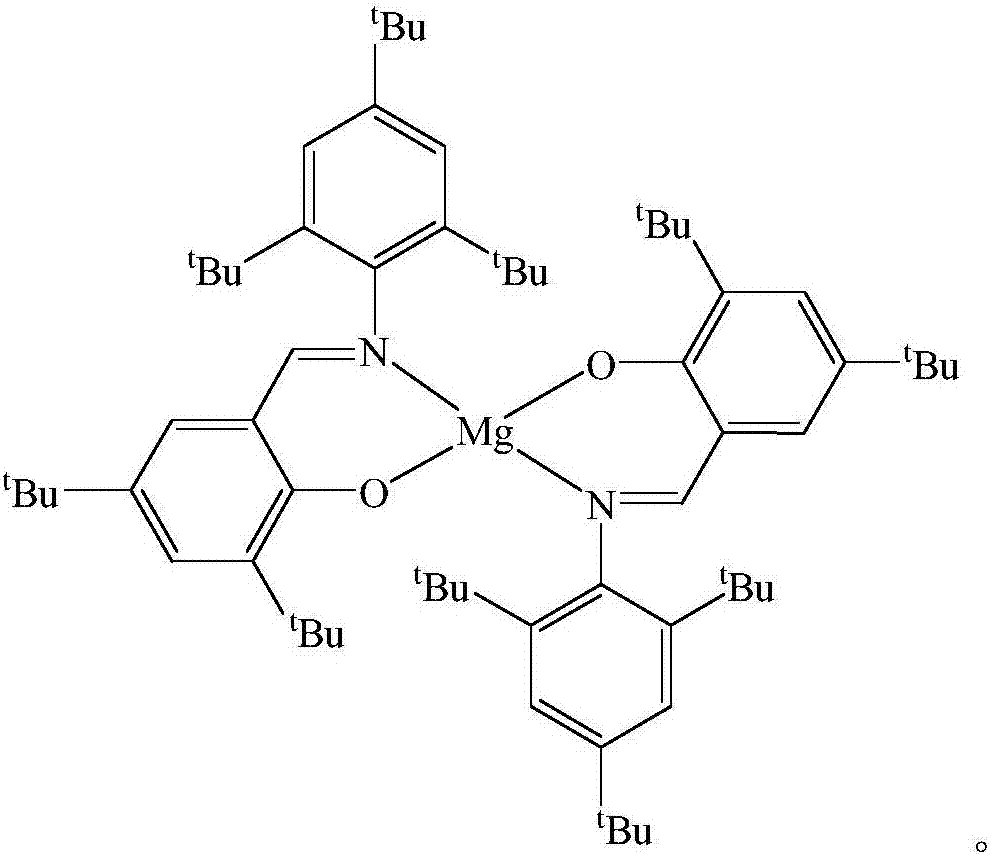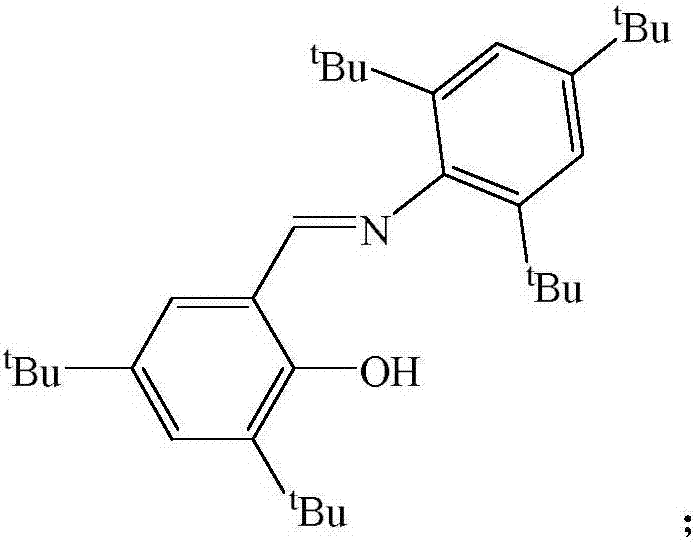A kind of Schiff base magnesium organic metal compound and its preparation method and application
A technology for metal compounds and Schiff base magnesium, which is applied in the field of metal organic compound preparation, can solve the problems of the synthesis and application of sodium magnesium bimetallic compounds without Schiff base magnesium, and achieves simple and easy operation, high yield, The effect of product purification
- Summary
- Abstract
- Description
- Claims
- Application Information
AI Technical Summary
Problems solved by technology
Method used
Image
Examples
Embodiment 1
[0036] The preparation of 2-(2,4,6-tri-tert-butyl)-3,5-di-tert-butyl Schiff base ligand is as follows:
[0037] 10.04mmol of 2,4,6-tri-tert-butylaniline, 10.04mmol of 3,5-di-tert-butyl salicylaldehyde, 1.67mmol of p-toluenesulfonic acid and 100mL of ethanol were added to a 100mL round-bottom flask, and the reaction was refluxed for 48h. A large number of light yellow crystals precipitated at -30°C, filtered, the mass was 4.32g, which was 2-(2,4,6-tri-tert-butyl)-3,5-di-tert-butyl Schiff base, the yield was 90% . M.p.178-180°C.
[0038] NMR spectrum: 1 H NMR (600MHz, 298K, C 6 D. 6 ): δ1.26(s, 9H, C(CH 3 ) 3 ), 1.38(s, 9H, C(CH 3 ) 3 ), 1.39(s, 18H, C(CH 3 ) 3 ), 1.65(s, 9H, C(CH 3 ) 3 ), 7.03 (d, J H-H =2.4Hz, 1H, Ar-H), 7.56(s, 2H, Ar-H), 7.63(d, J H-H =2.4Hz, 1H, Ar-H), 7.92(s, 1H, CH=N), 14.14(s, 1H, OH) ppm. 13 C{ 1 H}NMR (151MHz, C 6 D. 6 ): δ29.8, 31.6, 31.8, 32.4, 34.3, 35.0, 35.5, 36.1, 118.1, 122.2, 126.8, 128.4, 128.6, 137.8, 140.9, 141.0, 146.0, 148...
Embodiment 2
[0040] The preparation of 2-(2,4,6-tri-tert-butyl)-3,5-di-tert-butyl Schiff base ligand is as follows:
[0041] 10.0mmol of 2,4,6-tri-tert-butylaniline, 10.0mmol of 3,5-di-tert-butyl salicylaldehyde, 2.5mmol of p-toluenesulfonic acid and 100mL of ethanol were added to a 100mL round-bottomed flask, and the reaction was refluxed for 24h. A large number of light yellow crystals were precipitated at -10°C. After filtration, the mass was 4.2 g, which was 2-(2,4,6-tri-tert-butyl)-3,5-di-tert-butyl Schiff base, and the yield was 89%. . M.p.178-180°C.
[0042] NMR spectrum: 1 H NMR (600MHz, 298K, C 6 D. 6 ): δ1.26(s, 9H, C(CH 3 ) 3 ), 1.38(s, 9H, C(CH 3 ) 3 ), 1.39(s, 18H, C(CH 3 ) 3 ), 1.65(s, 9H, C(CH 3 ) 3 ), 7.03 (d, J H-H =2.4Hz, 1H, Ar-H), 7.56(s, 2H, Ar-H), 7.63(d, J H-H =2.4Hz, 1H, Ar-H), 7.92(s, 1H, CH=N), 14.14(s, 1H, OH) ppm. 13 C{ 1 H}NMR (151MHz, C 6 D. 6 ): δ29.8, 31.6, 31.8, 32.4, 34.3, 35.0, 35.5, 36.1, 118.1, 122.2, 126.8, 128.4, 128.6, 137.8, 140.9, ...
Embodiment 3
[0044] The preparation of 2-(2,4,6-tri-tert-butyl)-3,5-di-tert-butyl Schiff base ligand is as follows:
[0045] Add 9.0mmol of 2,4,6-tri-tert-butylaniline, 9.0mmol of 3,5-di-tert-butyl salicylaldehyde, 3mmol of p-toluenesulfonic acid and 100mL of ethanol into a 100mL round-bottomed flask, and react under reflux for 12h. A large number of light yellow crystals were precipitated at 4°C. After filtration, the mass was 3.86 g, which was 2-(2,4,6-tri-tert-butyl)-3,5-di-tert-butyl Schiff base, and the yield was 90%. M.p.178-180°C.
[0046] NMR spectrum: 1 H NMR (600MHz, 298K, C 6 D. 6 ): δ1.26(s, 9H, C(CH 3 ) 3 ), 1.38(s, 9H, C(CH 3 ) 3 ), 1.39(s, 18H, C(CH 3 ) 3 ), 1.65(s, 9H, C(CH 3 ) 3 ), 7.03 (d, J H-H =2.4Hz, 1H, Ar-H), 7.56(s, 2H, Ar-H), 7.63(d, J H-H =2.4Hz, 1H, Ar-H), 7.92(s, 1H, CH=N), 14.14(s, 1H, OH) ppm. 13 C{ 1 H}NMR (151MHz, C 6 D. 6 ): δ29.8, 31.6, 31.8, 32.4, 34.3, 35.0, 35.5, 36.1, 118.1, 122.2, 126.8, 128.4, 128.6, 137.8, 140.9, 141.0, 146.0, 148.5,...
PUM
 Login to View More
Login to View More Abstract
Description
Claims
Application Information
 Login to View More
Login to View More - R&D
- Intellectual Property
- Life Sciences
- Materials
- Tech Scout
- Unparalleled Data Quality
- Higher Quality Content
- 60% Fewer Hallucinations
Browse by: Latest US Patents, China's latest patents, Technical Efficacy Thesaurus, Application Domain, Technology Topic, Popular Technical Reports.
© 2025 PatSnap. All rights reserved.Legal|Privacy policy|Modern Slavery Act Transparency Statement|Sitemap|About US| Contact US: help@patsnap.com



